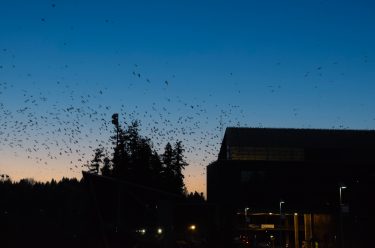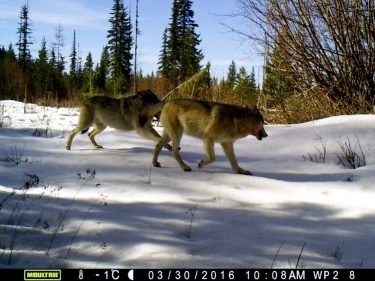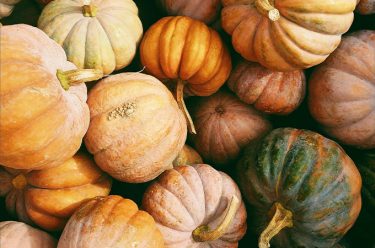As darkness falls across the land, we are once again at the time of year when temperatures drop, days shorten and scary things start popping up. Last year, we celebrated the season of all things spooky with slimy, creepy creatures found in Pacific Northwest waters. This year, we turned our attention to the land, and invited researchers at the School of Environmental and Forest Sciences (SEFS) to share a little about their favorite classic Halloween emblem. After learning a little more about these scary organisms, we hope it’ll help you be less afraid of the dark.
Crows

This time of year, do you feel like you’re being watched or hearing seemingly endless caws from huge traveling groups of crows? It’s not your imagination, and the reason stems from two reasons: the timing of crops ripening and crows’ annual roosting schedule. Many crops ripen in the autumn, which attracts crows looking for an easy feast. Even more enticing than fresh crops are rotten, bug-eaten crops, which causes swarms of crows to flock to the harvest. How delightfully revolting!
Territory-owning adult crows typically travel around in pairs throughout the year, but around this time of year, start spending less time on their territories and frequently join larger flocks in search of food. And by the fall, baby crows are big enough to leave their parents’ care and join a flock. Without territory to defend and with so many eyes looking for food, joining a flock is a win-win. This is the reason you’ll see massive flocks of crows flying above you, in search for their next meal.
Not spooky enough? Crows have been associated with death for millenia, likely starting in Europe during the Bubonic Plague when crows were seen feasting on corpses. Combine that with the beak-like masks filled with aromatics worn by doctors to protect themselves from the putrid air and the smell of death everywhere, it’s not hard to understand how these animals’ connection to death came about.
“I really encourage everyone to observe crows’ roosting behavior this time of year, especially in Seattle from the Montlake Cut to Lake City Way. When it starts getting dark in Bothell, the sky really turns into a Halloween scene with the crows and the sunset,” says SEFS’ Professor John Marzluff. Marzluff worked with others to develop an app to observe crows and learn about their behavior, named Crow Scientist and available on the Apple and Android app stores.
Wolves

Does the image of large predators in dark forests send a chill up your spine? When it comes to large predators, there’s no animal more polarizing than the wolf, which is simultaneously the symbol of compassion, recovery, the success of the Endangered Species Act and also the unknown wild. These nocturnal animals cause fear amongst both their prey and humans. But are wolves really an animal that humans should be so fearful of?
Wolves have been tied to humans as far back as up to 15,000 years ago, or even more, when they began lingering in packs on the outskirts of human encampments, scavenging on scraps that were thrown out. That tight relationship led to human domestication of wolves and the complex dynamic between humans and wolves – love because people domesticated them while simultaneously fearing the wildness they represent. Through time, those ancestral wolves evolved into the grey wolves that SEFS’ Aaron Wirsing studies today.
He notes that wolves have actually evolved to be fearful of humans, and might in very rare instances pose a threat only if they have lost their fear (e.g., because of habituation) or if they have become desperate (because their health is compromised, for example). Yet, “I think what’s fascinating with all the folklore and fairy tales around wolves—both contemporary and historical—is that they are a stand in for the danger of nature in stories. Even today, there’s this notion that wolves are waiting at the edge of forests to attack, symbolizing being alone and fearful in the woods. Thus, it’s not surprising that wolves are tied to the scariness of Halloween, to amp these feelings of fear up,” says Wirsing.
So the next time you see the silhouette of a big, bad wolf against the black sky accented with a full moon, just remember: these beasts may be more scared of you than you are of them.
Pumpkins
 There is nothing more synonymous with fall or Halloween than ripe, round, orange pumpkins. A variety of winter squash native to North America, pumpkins belong to the Cucurbita family (fun fact: this family also contains melons and cucumbers). Pumpkin and other squash take a long time to develop, which results in a fruit that is dense with carbohydrates and nutrients and ripens in the fall – hence the association with the season.
There is nothing more synonymous with fall or Halloween than ripe, round, orange pumpkins. A variety of winter squash native to North America, pumpkins belong to the Cucurbita family (fun fact: this family also contains melons and cucumbers). Pumpkin and other squash take a long time to develop, which results in a fruit that is dense with carbohydrates and nutrients and ripens in the fall – hence the association with the season.
A pumpkin’s life starts in the spring, as close to the last frost date as possible. At the UW Farm, pumpkin seeds are started indoors and then moved outside when the weather starts warming up. Each baby pumpkin plant is spaced three to four feet apart because they spread out and eventually fill in all the gaps with vines and leaves.
All squash plants have both male and female flowers on the same plant, but only female flowers can eventually develop into pumpkins and require pollination from another plant altogether. In recent years, there’s been a decrease in pollinators – like bees, birds and bats – due to pesticides, so UW Program on the Environment‘s Eli Wheat notes that it is important to focus on regenerative practices that feed bacteria and fungus in the soil instead of relying on crop pesticides. Another unexpected way to grow bigger pumpkins is to inject pumpkins with milk, and that extra protein is able to be broken down for extra growth.
Of course, we all think of pumpkins as the perfect thing to carve for Halloween. Generations of farmers have told stories of using vegetables like turnips, potatoes and rutabagas to carve scary faces into their tough flesh. Irish legend says that Jack’s lantern was lit to keep wandering evil spirits away from their crops, and immigrants brought this tradition with them to America. Pumpkins proved themselves to be the perfect vessel for jack-o’-lanterns with insides that can be easily scooped out, a flat bottom and hard exterior. The tradition continues to this day through this iconic member of the squash family.
This Halloween, we leave you with no tricks and only treats in the form of knowledge about these quintessential animals—and one fruit. Our hope is that this knowledge dispels some of the fear typically associated with wolves and crows and instead is replaced with reverence and a sense of understanding and appreciation.

